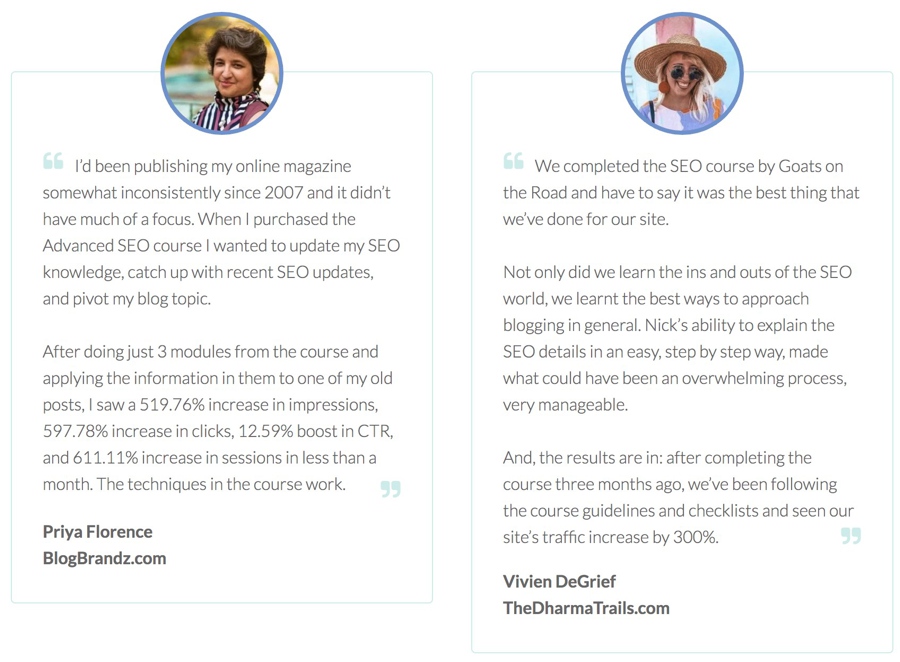Typically, there’s one main reason that bloggers don’t succeed. They write great content, they take amazing photos, but still… their traffic stays the same or simply goes up so slowly that it would take decades to actually have a successful blog. The key mistake that they’re making is not utilizing proper white-hat SEO strategies on their blog.
SEO = Search Engine Optimization (building a blog that Google will love)
The issue with SEO is that it’s not so cut and dry. There is “white hat SEO”, “black hat SEO”, and “grey hat SEO”, so not surprisingly, there’s a lot of grey area when it comes to actually growing your website traffic.
White hat SEO = Good, ethical, long-term SEO
Grey hat SEO = Questionable, fringe, risky SEO
Black hat SEO = Dodgy, spammy, short-term SEO
The issue that many bloggers have is that they think they’re doing white hat SEO, when in fact they’re encroaching on the grey and black areas of the practices. Then, when there’s a Google Algorithm update, or a MOZ Domain Authority update, they suddenly see their traffic and DA (Domain Authority) go down.
SEO isn’t difficult to do if you know how to get it right.
We managed to triple our traffic in a little over 12 months using the SEO tips that I’m going to share with you in this post. Once you start doing SEO the right way, you’ll see your traffic start to climb and if you simply repeat what works, it will snowball and suddenly you’ll see huge boosts in traffic like this:

Don’t have a blog yet? One of the major ranking factors that Google uses is Domain Age. This basically means it gives blogs more authority based on how long they’ve been online and publishing content. If you don’t have a blog yet, Click Here to start one today. You’ll get our free WordPress Beginner Blogger Course to show you how to write blog posts, add photos and design a blog quickly. The course isn’t just for travel bloggers. It can help you start any kind of blog you are passionate and knowledgable about.
1. Learn SEO From a Pro
Not to toot my own horn, but I’ve been blogging since 2012 and studying SEO for much of that time. I’ve also spent over $12,000 on SEO guidance for this blog, Goats On The Road, which is currently one of the most trafficked travel blogs online. I do consider myself an expert on the topic.
I’ve found what works, not just for my blog, but for many different blogs in different niches. My approach to SEO is quite simple, write great content that people will love and then give that post the chance it deserves by running it through some simple SEO checks and improvements.
We’ve helped hundreds of bloggers from all different niches grow their traffic quickly. In some cases, we’ve had our students see over 500% increase in traffic in under 60 days. I’m currently offering a 1 Hour SEO Training Session for free. My goal is to help as many people boost their SEO as possible. You can sign up for your free session today by Clicking Here.
CLICK HERE TO GET 1 HOUR FREE SEO TRAINING
Full disclosure here (because I’m a blogger trying to help other bloggers, not some pushy marketer), the above button will also include some useful SEO emails. And, at the end of the free training, you’ll have the opportunity to purchase our Complete SEO Course at a discounted rate.
The training video is not at all “selly” and you’ll learn a lot from it, whether you choose to purchase the full course or not. Just want to be 100% transparent.
I’ve listed this as the first SEO tip in this post because it’s already proven to help so many bloggers build their traffic.
2. Use KeySearch
These first two points in this post are pretty simple, I know. Sign up for free training and get a keyword research tool. Don’t worry, the more advanced stuff is coming up! But before we get into that, it’s important that you bite the bullet and pick up a proper keyword research tool.
Keyword research tools like KeySearch help you to find phrases that people are actually searching in Google. You can write posts all you want, but if you’re not writing what people search for, you will never get traffic.
There are two main reasons why I recommend KeySearch on this blog and to all of our blogging students. For one, it’s cheaper than most other tools on the market. At under $12 / month (when purchasing annually with a coupon code), it’s a steal. Other keyword research tools like Ahrefs cost $80 – $150 / month for similar functionality.
The second reason I recommend this tool is that it actually works. We were using free keyword research tools like Google Keyword Planner for years, but it wasn’t until we started using the advanced features in KeySearch that we actually saw our traffic grow.
The key with KeySearch (no pun intended) is to not use it on autopilot. Think of it like a DSLR camera. You can take decent photos on Auto mode, but to get those jaw-dropping results, you need to dive into the settings a little bit.
KeySearch gives you a very useful and intuitive “Difficulty” rating for each keyword, which tells you how hard it is to rank for based on the current competition in the search results. Don’t use this feature blindly!
You should also check the results manually to see if your blog is relevant enough to rank (Google uses domain relevancy as a ranking factor). Also, check to see the competitors DA and AUTH (number of external links pointing to the blog post) before committing to writing an article for your chosen keyword. T
here’s a lot more manual checking that we go over in the SEO training session, but checking these two things will give you a good head start.
Click Here to sign-up for KeySearch now and use coupon code GOAT20 at checkout to get 20% off the price. That link is an affiliate link so if you purchase through it, you’re helping to support us and the free content we’re sharing. We really do appreciate your support.
3. Use Must Words
Too many bloggers and webmasters out there simply use a keyword research tool and SEO plugin like Yoast and they think that’s enough to actually grow blog traffic. The truth is… it’s not. Yoast is a very basic plugin (particularly the free version) and while it can help you with your on-page SEO, that’s just one small piece of the larger SEO puzzle.
Content Assistant tools – like the one found in KeySearch under the “More Tools” tab – can have a massive impact on your blog post’s likelihood of ranking in Google. It doesn’t just tell you how to write your blog post, it also scans the top 10 results of search results for similarities. This type of algorithm finds what is known as correlation data and it’s priceless.
Assuming you’ve already written a blog post based on a good keyword that you found in KeySearch, it’s time to give it some love. When you’re done writing your post, go to the Content Assistant Tool in KeySearch and type the keyword you want to rank for into the search box at the top and hit “search”.
You’ll then see the right side of your screen populate with related keywords. These are “must words” which means they are words that KeySearch has found in all (or many) of the blog posts that currently rank for the term you’re trying to go for. By correlating the data with what is currently ranking, you’re able to build on your competitor’s successes.
Next, paste the text of your article into the box on the left and suddenly you’ll see the colors change next to the “must words” in the right column. Orange are the words you haven’t added to your post yet, while blue indicates ones you have. As the term “must words” suggests, it’s best to add as many of these as possible, as long as they’re relevant to your blog post.
While I’ve only explained how to do this using KeySearch, many professional keyword research tools have similar functionality.
4. Secondary & Related Keywords
The best way to get blog traffic isn’t to have a blog post rank for one keyword with high search volume. A better tactic is to have that one blog post rank for multiple keywords. A single blog post can include 20 – 100 secondary keywords and rank for many of them, meaning that the traffic compounds and you don’t have to write as many blog posts to get the same amount of traffic.
Before we started using KeySearch, we had a very hard time figuring out how to find secondary keywords that actually have search volume. These days we have some articles that rank for dozens of keywords. Some of these posts get as much as 35,000 page views a month by themselves, thanks to the excellent SEO that went into them and the wide variety of related keywords that they rank for.
KeySearch and other keyword research tools make it very easy to find secondary keywords that you can rank for. If you’re using the former, all you have to do is head back into the “Content Assistant” tab, type in the keyword you want to rank for, hit search and then click on “Keywords” in the right column.
This will populate a list of related keywords that you can add to your post. Super useful right? Now if you again paste your written post in the box on the left side, the colors will help you visualize which related keywords you’ve used, and which you can still add.
To take this strategy to the next level, you can then Export these keywords as a .csv file and go back to the keyword research tool and search each one to check their monthly volume and difficulty. If you can rank for 20 – 50 secondary keywords with a volume of 200 – 1000 each month, that can account for a lot of traffic.
5. Follow The Buzz
One underrated aspect of SEO is finding what is actually “buzzing” right now. BuzzSumo and Google Trends are both amazing tools for finding what people are currently interested in reading about in your niche.
BuzzSumo uses engagement algorithms across Twitter, Facebook and Pinterest, as well as backlinks and Reddit threads to find posts that are currently going “viral” in a particular niche. The best part is, it’s free. All you have to do is head to BuzzSumo.com and enter a topic you think you’d like to write about. BuzzSumo will then populate a list of articles from the web that are currently trending based on the indicators I listed above.
Seeing as Google filed a patent in 2015 to determine which social media accounts are fake and which are real, it’s clear that they’re using social sharing as a key ranking factor in their algorithms. If you can touch on a topic that’s proven to get a lot of shares and you can write it even better than what’s showing up in BuzzSumo and Google Trends, then you have a higher chance of getting more traffic quickly.
While keyword research tools like KeySearch are great for finding keywords that have been getting traffic for a long time, sometimes trends come out of nowhere and these types of tools don’t have time to populate the data. This is where buzz SEO can be super useful.
A good example of this is back in 2011 when there were issues in Egypt. Typically terms like “is it safe to travel to Egypt” hardly get any searches. But during the height of the revolution (and still to some extent today) these numbers were seriously inflated. By writing on topics like this while they’re “hot” you can not only drive more traffic to your blog, but you can also help inform the masses about what is going on now.
A Couple of Bonus Tips
As usual, I’m following my own recommendation and trying to make this post as useful as possible so that it has a better chance of ranking, and so that you’re more likely to gain something from it (and maybe share it?). Here are a few bonus SEO tips that you can utilize to grow your blog traffic quickly.
Speed Up Your Site
One of the major ranking factors Google uses is site speed. Studies have shown that more than 40% of users will leave a website if it takes more than 3 seconds to load the page. That means if your site currently takes 4 seconds to load, then you could increase your traffic by 40% by simply shaving off that extra second.
The issue with site speed is that it is often complex and hard to understand. You can install a caching plugin like W3 Total Cache to your site and add a CDN like CloudFlare, but if you don’t get the settings just right you can actually slow down your site and in some cases, break it completely.
It sounds scary I know! We cover exactly how to speed up a site the right way in our Complete SEO Course, but for now, the least you should be doing to help your site speed is to simply set up a caching plugin and CDN and leave the settings as they are. You may not shave off a lot of load time, but it’ll be a start.
Do A Guest Post Bomb
I’ve written about this already extensively on this blog. The importance of guest posting is highly underrated these days. When we started out we spent 30% of our time writing blog posts for other websites because we had no traffic yet. This accounted for a 50% increase in traffic over a 2 month period. Even established blogs should have at least a few guest posts published each month.
Too many bloggers these days are taking the easy way to get backlinks, like doing link swaps and collaborative posts. This may give short-term gains but these are typically viewed as spammy by Google and because there are so many other do-follow outbound links in the post, it usually means that the link equity has been depleted massively.
Check out this post about my guest post bomb strategy and utilize useful guest posting as your main way of building backlinks (even if it takes a little bit longer).
Link Out, Not Just In
Most bloggers know the importance of building backlinks, but few actually know how important it is to link out to relevant, high authority websites within blog posts. Google is all about helping user experience and in most cases, if a reader can click a link to learn more on a well-known website like Wikipedia, Google will reward you for making things easy for your readers.
Every blog post should have at least 2-3 outbound links that help the user experience, as well as numerous internal links to other relevant blog posts on your site.
Write For Humans First, Bots Second
This is a famous phrase from Neil Patel and I think it is absolutely true. One of the major mistakes that SEOers make when writing blog posts, is that they don’t think of the people who are going to be reading their content, and instead write for the Google robots that crawl their site.
The result is keyword stuffed, grammatically incorrect, unreadable blog posts that nobody will find useful or will bother to share. The key to good SEO is longevity. Writing great content that people will find extremely useful and hopefully share on their social platforms.
When you’re writing blog posts on your blog, your first goal should be to help solve your readers’ problems, the second goal should be to use SEO so that Google ranks your post and helps you get more readers. It’s the chicken before the egg philosophy and it’s the only way to get long-term traffic from search engines.
In Conclusion
If you want your blog to get more traffic, you should be thinking about the long-term, not the short term. Very successful blogs write great content and use proper white-hat SEO so that their traffic continues to grow over time.
Don’t just use one of these SEO tips. Utilize as many SEO strategies as you can and combine them to see real results in your traffic. In our Free SEO Training we go over these strategies in great depth and while this post is only a fraction of what we go over in our course, we break things down in an easy-to-follow format with a useful SEO Calendar that will help make sure you complete the right tasks and do the right checks day in, day out.
It took us years to finally take our SEO seriously, and from the minute we actually invested some time (and money) into our SEO, we saw immediate results. For us, tripling our traffic not only meant that we more than doubled our monthly income, but it also meant that we were able to spread our message further and have a greater impact with our blog.
CLICK HERE TO SIGN-UP FOR FREE
There are a lot of free keyword research tools online and there’s a lot of free information out there, but it’s often hard to put it all together and come up with a strategy that works. Our Complete SEO Course goes over the basics that you’ll find for free online, but it also covers advanced strategies and our own personal SEO secrets that have helped us to grow our traffic to over 375,000 users per month.
If you have your blog solely for the purpose of a diary, then you don’t have to worry about the SEO tips in this post and in our training. But if your goal is to reach a wider audience, have a bigger impact and make more money blogging, then you shouldn’t write another post on your blog without utilizing proper SEO. There’s no point in wasting your time writing great blog posts if no one will ever read them.
Take your blog to the next level and learn how to build a blog that Google will love. It can change your business and your life forever.
Like This Article? Pin it!


















